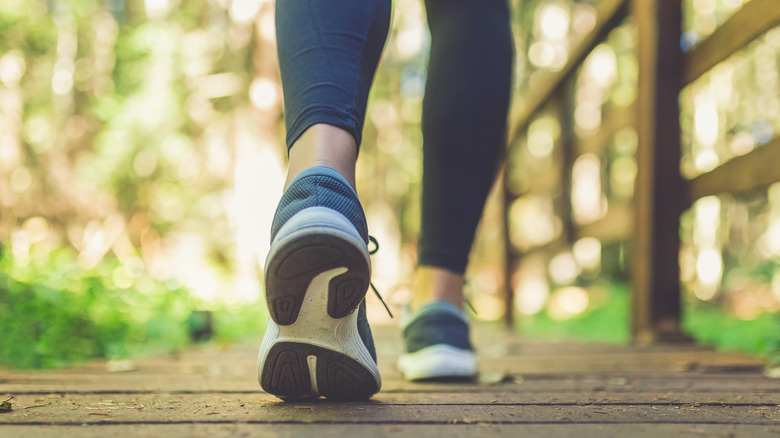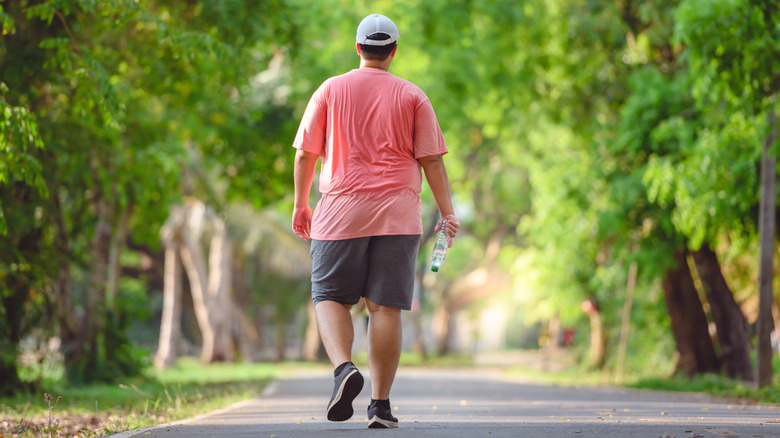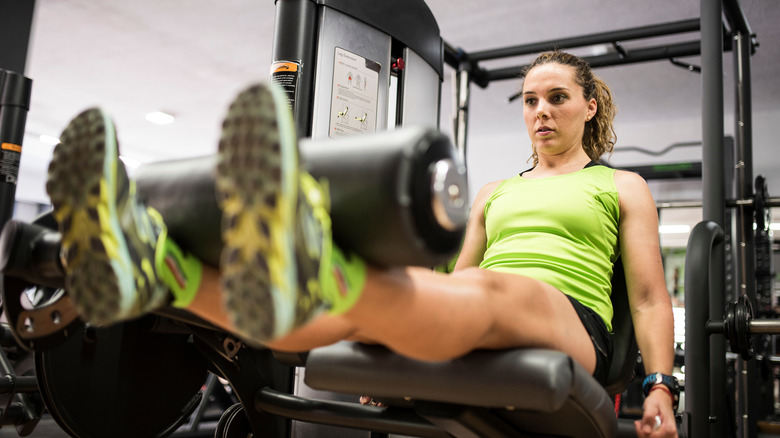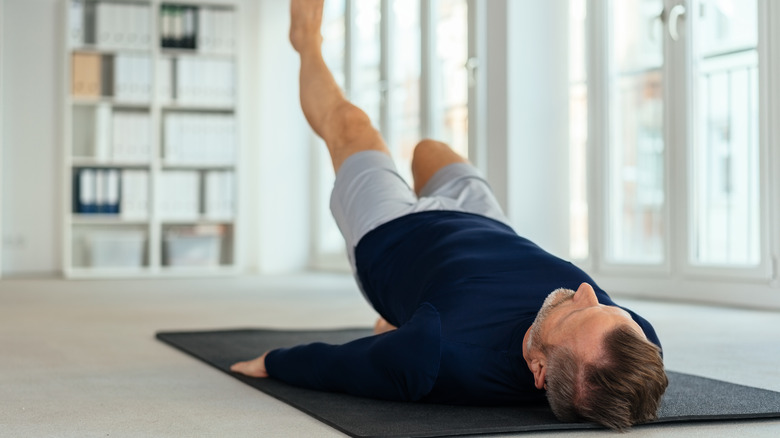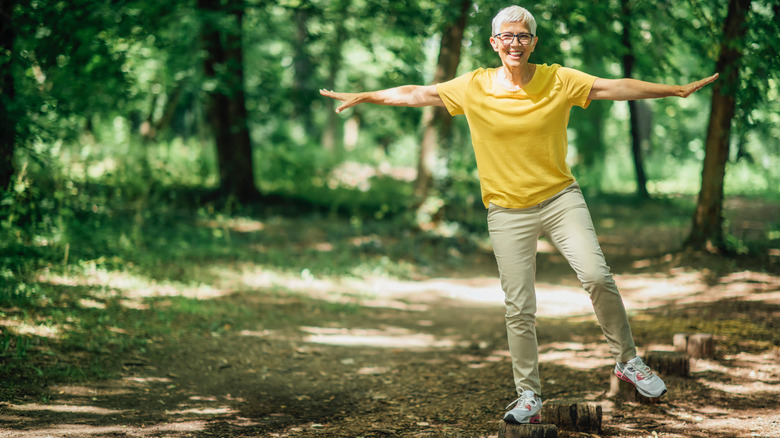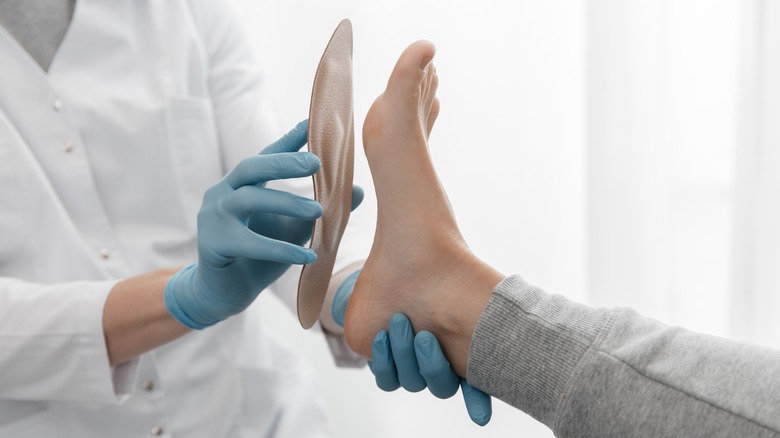How To Fix An Uneven Gait For Healthier Strides
Walking is something you've likely done almost every day since you were two years old. Although walking is something you learn by doing, many of us have asymmetry when we walk (via Bustle). That means that we might favor one leg over the other, or one leg will take a longer stride. You might even stand on one leg a little longer than the other when you walk. Perhaps one foot points out when you walk, while the other foot points straight ahead. Although it might seem meaningless that one foot is at an angle, a slight imbalance in your walking stride can easily add up throughout the day — particularly if you're aiming for those 10,000 steps each day.
An asymmetrical stride can set you up for pain in other parts of your body (via Bustle). If you're favoring one leg, it could manifest as back pain. You could easily suffer injury if you trip and land on your weaker leg, which can't stabilize you. If you're a runner, imbalances in your stride could significantly slow you down, because you're using more energy to accommodate for the imbalance (via Runner's World).
Recognizing asymmetry in your gait
There are a few ways you can see where your imbalances might be, according to Runner's World. First of all, you can have someone take a video of you while you're running or walking to see if you're favoring one leg. If you do lunges in a mirror, look at how your front knee tracks. If it tracks inward or outward, it might indicate weak glutes or hips. You could also purchase some tech insoles like Nurvv, which analyze your stride for you.
If you have an iPhone 8 or higher with iOS 15, you can check your walking symmetry through the Health app, according to Apple. Just open the Health App, and navigate to the Summary, then the Health Checklist. Find the Walking Steadiness notification and be sure it's turned on. Then wear your iPhone in a pocket near your waist as you go about your day. The Walking Steadiness studies your balance, stability, and coordination and will notify you if it's low or very low.
To view your walking stats, go to Show All Health data. If you check out your walking asymmetry, the number shows how often during the day you took imbalanced steps. Lower percentages are better, according to Bustle. Older adults might range from 15 to 20%. If you want to correct some of your imbalances, there are a few fixes that can help.
Strengthen your legs
According to Sante Rehabilitation, you can do some easy exercises on a chair, particularly if you're just coming back from an injury. You can strengthen the muscles of your calves and shins by doing heel and toe raises on a chair. To work your calves, press your toes into the floor while raising your heels. To activate your shins, ground your heels and lift your toes. Flint Rehab says you can make it more challenging by doing these exercises standing, but be sure to hold onto a chair or other stable surface.
To really work on imbalances, you'll need to isolate each leg, according to Bustle. Isolated leg extensions and leg curls can point out which muscle might be weaker. Lunges will also help isolate the weaker leg, so start with doing enough reps to challenge the weaker side, then do the same amount of reps with the stronger leg.
Flint Rehab also suggests working the outer hips to help with stability. Stand next to a chair and balance on the foot closest to the chair. Raise the opposite leg out to the side about 45 degrees, then return to start. That's one rep. Repeat for a total of 15 reps, then turn around for the opposite leg.
Don't forget your core
Your core is also integral to your stride balance, so Sante Rehabilitation suggests some exercises to make you more aware of how your core affects your stride. Sit upright on a chair and draw one knee towards your chest, focusing on core activation. Lower that leg, and raise the opposite leg. Continue with this seated marching for 10 reps. You can also work your core by lying on your back and raising both knees towards your chest.
Your core also includes your glutes, so single-leg glute bridges will help with your core stability, according to Runner's World. Lie on your back with your knees bent and feet planted on the floor. Raise one leg into the air, and press your hips up evenly using the glutes of the grounded leg. Pause for a few seconds at the top, then repeat for 10 to 12 reps. Return the hips to the floor and switch legs.
Balance exercises to fix an uneven gait
Because walking is a full-body exercise, it's important to work on your balance and coordination, according to Flint Rehab. If you've ever seen a flamingo, you'll know what a flamingo stand looks like. Try standing on one leg for 30 seconds, holding onto something stable nearby. Then move to the other leg. If this is easy, work towards standing on a single leg without the support of something nearby to anchor you.
Runner's World says that you can take it one step further by doing single-leg taps. Start by standing on your left leg while picking up your right foot. Hinging from your hips, bend forward and try to touch your left fingers to the floor. Repeat 10 to 12 times while balancing on your left foot and keeping your right foot off the ground. Then do the same with your right leg. You can also do simple balancing exercises by using a balance or wobble board every day, according to Bustle.
When to see a doctor
If your uneven gait follows a fall or if you can't speak clearly, it might be best to see your doctor, according to Healthline. You should also see your doctor if your asymmetrical stride also accompanies dizziness, confusion, breathing problems, incontinence, or a severe headache. Your doctor will review your medical history and look at your gait using the Functional Ambulation Classification Scale to see how well you can walk on your own. It's possible that some of your medications, mental health conditions, cardiovascular disease, or neurological disorders could explain a gait imbalance. Your doctor or physical therapist could recommend an orthotic to help stabilize your gait (via Bustle).
While working on your uneven gait, you can take preventative measures to avoid falls at home. Clear any clutter around your walking path, and be sure that these areas are well-lit. Use non-slip mats in the bathtub and the bathroom floors, and wear shoes that have a tread to avoid slipping around the house (via Healthline).

